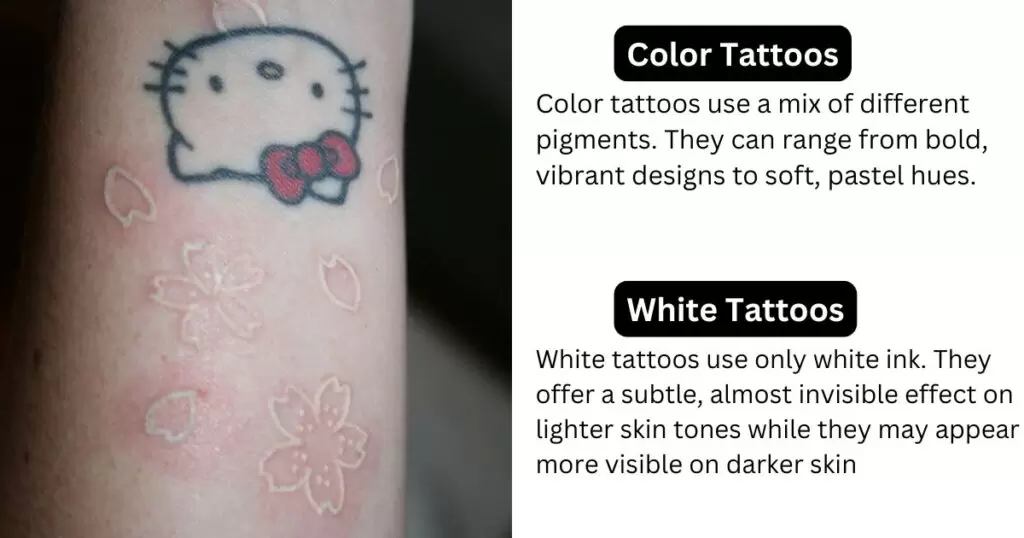Tattoos are a form of self-expression. They allow people to carry art on their skin. The popularity of white and color tattoos has been growing, with many seeking unique designs that stand out.
While black ink remains the most common, white and colored tattoos offer a different look.
What Are White Tattoos?
White tattoos use only white ink. They offer a subtle, almost invisible effect on lighter skin tones. On darker skin, white tattoos may appear more visible but may also fade faster. White tattoos are often chosen by those who want a more delicate or hidden tattoo.

White ink is thicker than traditional black or color inks. It can be challenging for tattoo artists to work with, requiring skill and experience. This type of tattoo can appear raised, resembling a scar. The final look depends on the skin tone and how the body heals after the procedure.
Pros of White Tattoos
White tattoos are subtle. They blend in with the skin, making them a great choice for those who prefer a more minimal design. They’re ideal for areas of the body where tattoos need to be less noticeable, like hands or necks. The ink’s subtlety can make the design look elegant and unique.
Cons of White Tattoos
White ink fades faster than other colors. It may also turn yellow or dull over time, especially if exposed to the sun. This makes white tattoos more challenging to maintain. Touch-ups may be required to keep the design fresh. People with darker skin tones may find that white tattoos do not stand out as much as they had hoped.
Another drawback is the healing process. White ink can blend with the skin during healing, making it difficult to see the final result for several months.
What Are Color Tattoos?
Color tattoos use a mix of different pigments. They can range from bold, vibrant designs to soft, pastel hues. Color tattoos are versatile, allowing for more detailed and realistic designs compared to black or white ink.

Artists use various shades to create depth and dimension in the tattoo. Popular choices include reds, blues, greens, and yellows. They offer an opportunity to get creative with designs, from bright flowers to complex portraits.
Pros of Color Tattoos
Color tattoos allow for greater creativity. The wide range of colors gives artists more freedom to design vibrant and eye-catching pieces. The use of color also adds dimension, making tattoos appear more lifelike.
For those looking for personalized tattoos, color ink offers a lot of options. You can blend colors to create shading and detail that wouldn’t be possible with just black or white ink.
Cons of Color Tattoos
Color tattoos tend to fade over time. Lighter shades like yellow or light blue are the most prone to fading. Sun exposure is a major factor in this process. To maintain the vibrancy of a color tattoo, it’s important to avoid direct sunlight and use sunscreen.
Another issue with color tattoos is that not all pigments work well on every skin tone. Darker skin may not show certain colors as vibrantly as lighter skin, which can limit color choices. Additionally, some people may have allergic reactions to specific color pigments, although this is rare.
White vs. Color Tattoos: Which Is Better?
Choosing between white and color tattoos comes down to personal preference. White tattoos are subtle and ideal for those who want a discreet design. However, they may fade quickly and require more maintenance. Color tattoos offer more variety and vibrancy, but they also need touch-ups and sun protection.
Consider your skin tone, lifestyle, and tattoo placement before making a decision. If you want a tattoo that stands out, color ink may be the better choice. If you’re looking for something minimal and subtle, white ink could be the way to go.
FAQs About White and Color Tattoos
Can your body reject white tattoo ink?
Yes, your body can reject white ink, leading to fading, irritation, or uneven healing.
Can You Mix Color and Black and White Tattoos?
Yes, you can mix color with black and white tattoos for contrast, shading, and dynamic designs.
Will a white tattoo turn yellow?
Yes, white tattoos may turn yellow over time, especially with sun exposure or improper care.
Are white ink tattoos more expensive?
White tattoos are often more expensive due to the complexity and extra skill required by the artist.
Do white tattoos hurt more?
No, white tattoos don’t typically hurt more than other tattoos, but placement and skin sensitivity matter.
How long do white ink tattoos last?
White ink tattoos tend to fade faster, often lasting 1-3 years before needing touch-ups.
Is white a good tattoo color?
White can be a good tattoo color for subtle designs, but it fades and may not suit all skin tones.
Can white tattoos be removed?
Yes, white tattoos can be removed, but they are harder to remove than darker ink.
Final Thoughts on White and Color Tattoos
Both white and color tattoos offer unique benefits and challenges. White tattoos provide a subtle, delicate look, while color tattoos give you more design options. The key to making the right choice lies in understanding what you want from your tattoo and how much maintenance you’re willing to commit to.
Either way, choosing a skilled artist and following proper aftercare will ensure your tattoo looks great for years to come.



